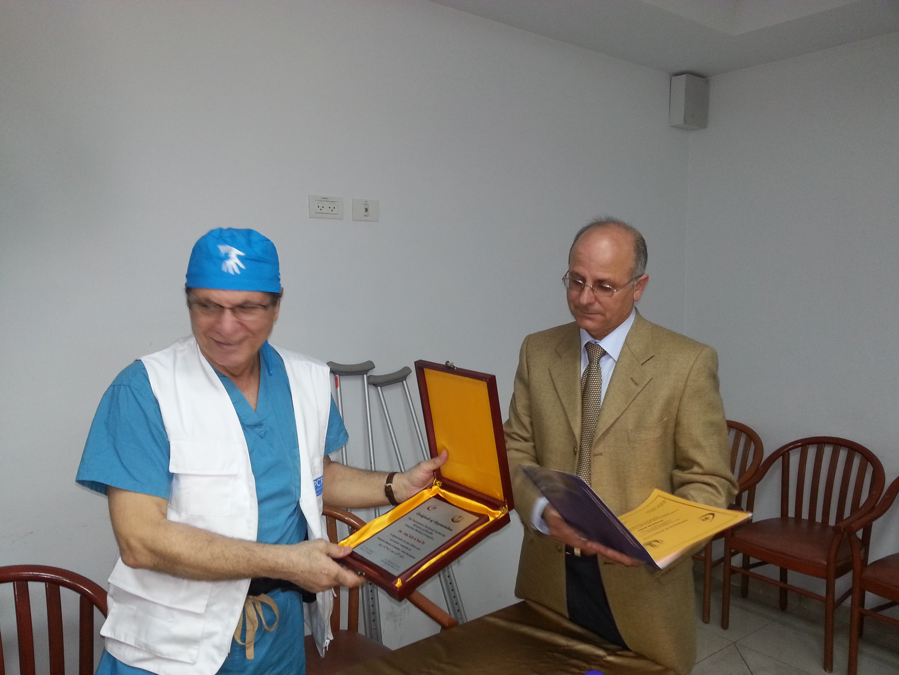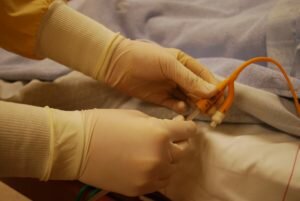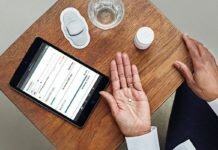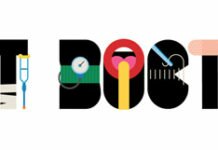For the past 40 years, Dr. Saad Saad has performed thousands of complex pediatric surgeries on children of all ages, from infants to teenagers. While he is based in Eatontown, New Jersey, he has participated in eight Medical Missions to Jerusalem to perform free complex surgeries on poor children. He has patented two inventions and developed many new pediatric surgical procedures.
What inspired Dr. Saad to go into the medical profession?
In an interview, he tells the story: “When I was attending high school in Kuwait in 1965, I first thought I wanted to be an engineer like my two older brothers who were working outdoors in construction.”
Dr. Saad continues: “Kuwait has very hot summers where it’s not uncommon for the temperature to exceed 110 degrees F. After a few summers I realized I wanted to have a profession where I would be working indoors with air conditioning available.”
“So I selected to not only be a doctor but to become a surgeon working in an air-conditioned operating room,” he said.
Dr. Saad shows his good sense of humor in telling that story. But his long list of medical accomplishments illustrates the more serious side of this man. Throughout his career, Dr. Saad has used his skills as a surgeon – and a natural talent for engineering – to improve the lives of others.
Who is Dr. Saad Saad?

Saad Saad was born in Palestine, raised in Kuwait, and was one of eight children – three surgeons, two PhD and two Master Degree in engineering and a teacher. He earned his medical degree 47 years ago from Cairo University in Egypt with honors and ranked second in his class.
“I did really well in Medical School,” says Dr. Saad. “In fact, I graduated from my medical school with honors as the salutatorian. I came from a poor family so I had no choice but to do my very best in med school.”
In his 3rd year as a medical student in 1964, Saad purchased a $99 airline ticket from Cairo, Egypt to Beirut, Lebanon to take his ECFMG exam. He passed that exam, which allowed him to train in the US after he completed his formal medical education. “That certification changed my life forever,” says Dr. Saad.
He completed his internship in England and then immigrated to the U.S. 45 years ago. He did his residency in surgery and in pediatric Surgery in the US Board Certified in Pediatric Surgery.
During his career, Dr. Saad served as the Surgeon-in-Chief and the Co-Medical Director of K Hovnanian Children Hospital at Hackensack Meridian Health Care System in New Jersey. His was a very productive surgical career treating pediatric patients inside and outside his community — always pushing to improve surgical techniques to benefit his young patients.
That dedicated career was interrupted in the 1980s by a singular opportunity, one that took Saad and his family back to the Middle East. He was asked to serve as pediatric surgeon for the Saudi Royal family.
Rare Opportunity in Saudi Arabia
How did Dr. Saad Saad, a New Jersey doctor, qualify for this unique experience? Two reasons — he was the only board-certified pediatric surgeon in the U.S. who fluently spoke both Arabic and English.
In the U.S, board certification is difficult. Special training, continuous surgical practice, and passing a rigorous exam every ten years are required.
For almost anyone, moving to a different country—especially Saudi Arabia—would be a difficult transition. At first, Dr. Saad went to Riyadh, Saudi Arabia for a month to find out more about the job. He said that he was treated like royalty during this time. Because he knew Arabic, he felt very comfortable. He never felt out of place in Saudi Arabia.
This was also a golden opportunity for his career, one that very few people ever receive – a chance to work for the Royal Family. Dr. Saad took the job in 1985 and stayed in Saudi Arabia for the next four-and-a-half years.
An Unexpected Adventure
For Dr. Saad and his family, the stay in the Saudi city of Riyadh proved to be a very positive adventure.
Dr. Saad was happy to use his surgery skills to help prestigious patients and to earn the trust of the Royal Family. He enjoyed giving lectures to the surgical club and spreading his knowledge to others.
Dr. Saad and his family also enjoyed meeting people from all over the world in Saudi Arabia. With his family in tow, he used his free time to visit friends in Denmark, Sweden, Ghana, Egypt, England, Canada, Hawaii and many other exciting places.
Treating the Smallest, Sickest Patients
In Riyadh, Dr. Saad worked at the King Faisal Specialist Hospital. The Protocol Office and the chief of the hospital called him into service to perform the simplest to the most complex surgeries. Most of the nurses and the doctors at the hospital were highly trained in the U.K. or in the U.S. and had the opportunity to work with the best medical equipment available.
During this time, Dr. Saad performed surgery on the youngest baby to have ever been admitted with an aneurysm. He saved the baby’s life, and he was able to convince a noted world-class scientific journal to publish the details of this challenging case in order to educate others.
The Protocol Office and the chief of the hospital highly respected Dr. Saad’s opinion as an experienced surgeon. His suggestions were taken very seriously — whether to perform surgery at the hospital – or to fly the patient abroad. In one occasion, an assistant chief at the hospital personally trusted Dr. Saad to perform surgery on his son at King Faisal Hospital instead of flying him abroad.
Serving Both Rich and Poor
Although King Faisal Specialist Hospital primarily serves the Royal Family of Saudi Arabia, the royals from Bahrain, the UAE, and the Persian Gulf were treated at the hospital as well.
However, the Saudi Family also opens the Hospital to serve the very poor with the most complex pediatric surgical problems.
Dr. Saad understands what it’s like to be poor. “I came from a poor family so I had no choice but to do my very best in med school,” he says.
His mentor, Dr. H Biemann Othersen in Charleston, SC, emphasized one principle – that people are equal and deserve equal opportunities.
“The most valuable lesson I learned from him was to be kind, honest, hard-working, and to treat all children the same regardless of their color, religion, mental or physical abilities, or financial status,” Dr. Saad recalls.
In the U.S., Dr. Saad served his community but also helped children and young adults in the Holy Land. This included four Medical Missions in the U.S. and eight Medical Missions to Jerusalem and the West Bank to perform free complex surgeries on poor children.
With this opportunity in Saudi Arabia, Dr. Saad was given yet another opportunity to serve the poor by giving their children the very best surgery.
Creating a Surgical Residency Program for Saudi Students
On an everyday basis, Dr. Saad was a busy surgeon, but he did much more than perform his duties as a surgeon.
He saw the need for a Surgical Residency Program in Saudi Arabia – so he helped develop that program. He established a working connection and approval of the Royal College of Surgeons in England for students to receive their U.K. certification at home in Saudi Arabia.
Dr. Saad is proud of this achievement which the Saudis considerable remarkable. Because of him, many students now have the opportunity to stay at home in Saudi Arabia for surgical training instead of having to train abroad.
Dr. Saad’s Family Time in Saudi Arabia
Saad’s children were very young during their time in Saudi Arabia. He knew very clearly that the move would have a significant impact on his family and took that into account when accepting the job.
Originally, Dr. Saad was supposed to stay in Saudi Arabia for only a year. But he and his wife did not want to move the kids too much as they were growing up and receiving their early years of education.
So as a result, they extended their stay. In fact, the family enjoyed their stay so much they would have stayed longer, but that meant the kids would have to be sent to boarding school abroad to continue their education. Dr. Saad and his wife wanted their kids to grow up as the family, not at a boarding school.
Dr. Saad’s time at King Faisal Hospital eventually had to end so he could return back to life in the U.S. to be closer to his family and have his children attend local schools. He was a high-demand surgeon, which is not an easy profession. His skills were needed in his New Jersey hospital.
In an interview, Dr. Saad mentioned that the Saudi experience could have been possible without the support of his wife. Having her support made his demanding jobs in Saudi Arabia – and in the U.S. – a lot easier, he says.
Pediatric Surgeon With Engineering Talents

As a surgeon, Dr. Saad focused on improving existing surgical procedures. He always challenged standard practices in seeking ways to improve surgical techniques and reduce the risks and pain his patients experienced.
That focus resulted in two patented inventions and many new pediatric surgical procedures. He holds the patents for both of his medical inventions, a newly designed catheter and a suction endoscope.
Invention #1: Catheter with Tracking Mechanism
Medical catheters are tubes that can serve multiple functions. In some cases, these tubes are inserted into the body to perform a surgical procedure or to treat a medical condition. Catheter tubes can drain gases and fluids, provide access for surgical instruments, as well as perform a myriad of other specialty as there are many types of catheters. Some catheters are placed in the body to perform a function on a permanent basis. Many catheters are needed on a short-term temporarily basis.
The problem: To place a catheter in the right location inside the body, surgeons must be able to easily track its exact position. An x-ray is the traditional imaging device used for this task. However, while a single X-ray does not put either patient or surgeon at any significant risk of illness, exposure to frequent X-rays does pose a serious concern — as it involves repeat doses of radiation.
An MRI (Magnetic Resonance Imaging) may be an alternative to an X-ray to track the catheter. But MRI machines are large, are not portable, and the procedure is expensive — all factors making MRI an impractical alternative option.
The solution: Dr. Saad created a device that helps locate the catheter without any kind of machine scan of the patient’s body.
How Dr. Saad’s Catheter Works
Dr. Saad’s catheter design utilizes electromagnetic energy to identify the catheter’s location. His invention has been compared to a metal detector in that regard.
In his invention, he has outfitted the catheter tip with a coil and magnetically permeable material. The catheter also has a pair of wires inside its walls. With this combination, the surgeon can use an external locating device to scan the outside of the patient’s body. The locating device sends signals to the catheter’s coil tip and to the magnetic material — identifying the location of the catheter.
Just like a metal detector, the external device can sweep outside of the patient’s body. When the external device is over the catheter – and is situated at the catheter’s tip – output voltage passes through the wires. This illuminates the light in the external locating device, letting the doctor know that the device is directly over the catheter.
Because of Dr. Saad’s invention, patients are able to avoid X-rays and MRI scans to locate the catheter. This device is small, portable, and practical, allowing doctors to use it in the ICU in emergencies when there might not be time to perform a body scan to find the catheter.
With this invention, doctors can also avoid using guide wires to track the placement of the catheter when the catheter is first inserted inside the patient. These guide wires can break and get stuck inside the patient, which is potentially hazardous.
Invention #2: The Visual Suction/Irrigation Rigid Endoscope
Dr. Saad’s second invention improves another common medical device known as the endoscope. Endoscopes are optical devices that surgeons use to view inside the patient’s body during an examination or surgery.
With an endoscope, the surgeon can examine inside the throat, the windpipe, even the bladder, stomach, and colon. These endoscopes can be extremely useful in providing the doctor with a visual picture of what is going on inside the patient’s body without surgery or performing a body scan.
The problem:
Dr. Saad recognized a problem that every surgeon faces in using an endoscope. The body’s internal fluids create difficulty for the surgeon who must view an organ via an endoscope. These liquids can fog the endoscope’s lens, obstructing the physician’s view.
In the traditional design, the endoscope has to be removed and a suction tube inserted to vacuum away the liquid. After the suction is performed, the endoscope has to be reinserted and the doctor has to relocate the site under investigation.
The solution:
Dr. Saad’s endoscope features an anti-fog port with a suction-irrigation device to clear up the view. This provides the surgeon with an unobstructed view. The irrigation feature allows the doctor to inject fluid to wash the area, then sucks the fluid to provide a clear view for the doctor during the endoscopy procedure.
Today, endoscopes used for bronchoscopy, esophagoscopy, and sigmoidoscopy are being fitted with Dr. Saad’s anti-fog suction device. The physician performing the endoscopy can use this device to suck away liquid that is hindering their view without having to remove the endoscope.
Dr. Saad personally attests to the useful features of this device. He has performed thousands of endoscopies during his career as a pediatric surgeon, helping remove any foreign bodies such as marbles, needles, stuck food, or whatever else a child may have swallowed or inhaled from their body.
His device eliminates the start-and-stop involved in readjusting the scope’s focal point. His suction device makes the procedure easier because the doctor never has to move the eye away from the scope.
Because the suction and irrigation device is practical and inexpensive to produce, this invention is frequently used by doctors today.
Necessity is the Mother of Invention
When Dr. Saad is asked why he decided to invent these two devices, he simply answers that “necessity is the mother of invention.” Both his devices help doctors perform their tasks in a safer and more practical manner.
Because his catheter eliminates the need for body scans and a guide wire, Dr. Saad’s invention allows physicians to prevent complications and perform their tasks in a faster, safer manner. The same is true of his endoscope device, as the doctor avoids removing the scope during the procedure.
Dr. Saad’s catheter invention has not yet been widely used. Manufacturers have been discouraged by the complexity of the invention.
However, a large medical company in Utah has shown interest in the catheter device, and it will likely be available for doctors in the future. This is a very practical solution that keeps patients safe and makes the procedures easier for physicians.
Technology in the medical industry is constantly changing, says Dr. Saad. For him, it is a win-win to invent devices that make the lives of doctors easier while keeping the patients.
He finds great satisfaction in using his personal experience – and his natural engineering talents – to not only perform his duties as a surgeon, but to also create innovative devices that will further revolutionize health care.
Reflecting on His Long Career
Dr. Saad is now retired and living in Red Bank, NJ. He says, “If a poor Palestinian refugee can make it and be successful in America, you can too. Work hard and persevere!”
He has life-long connections with people from all over the world, all because of his position as the pediatric surgeon for the Royal Family. He is happy his kids made international friends and received a first-rate education in Saudi Arabia. Saad has been married for 42 years and his four children are now two Surgeons, one Lawyer and an ICU Nurse.
Recent Interview Yields Insights
In an interview, Dr. Saad answered questions designed to provide insights into his medical and surgical career, and his personal philosophies. A few samples:
What emerging medical trend most excites you about the future? “How genetics are impacting our ability to understand, prevent, and treat cancer and other chronic diseases.”
How do you bring your ideas to life? “Research is so important. Research leads to results.”
The one habit that has made him more productive? “Organization. When I’m organized, I’m more efficient and won’t procrastinate the assignments that I’m expected to accomplish today.”
What advice would you give your younger self? “Reaching your goals is not impossible if you insist on it.”
What emerging medical trend most excites you about the future? “How genetics are impacting our ability to understand, prevent, and treat cancer and other chronic diseases.”
Tell us something that’s true that almost nobody agrees with you on. “Only God knows our fate.”
Dr. Saad’s Rules of Surgery
He shares the details of his surgical protocols to help young surgeons in training. These habits were most helpful in preparing for surgery:
- Review the patient Medical Record and confirm what type of surgical procedure I am planning to do.
- Review the steps of the surgical procedure I’m planning to do. Complex pediatric surgical procedures from the most recent operative pediatric surgical textbook, especially.
When performing a complicated task like surgery, these rules helped him focus:
- No personal talking in my operating room
- No loud music
- A good night’s sleep and a good breakfast prior to surgery
All Are Created Equal
Dr. Saad recommends reading any book about President Abraham Lincoln, who freed the slaves and reiterated that all people are equal. “We are all equal in the eyes of God. Through the eyes of a pediatric surgeon, I know that all people were created with the same heart, lungs, liver, intestines, and other organs, no matter that person’s race, color, or religion,” he says.
Connect:
Dr. Saad Saad on Facebook:
Dr. Saad Saad on LinkedIn:
Dr. Saad Saad on Crunchbase: https://www.crunchbase.com/person/saad-saad














